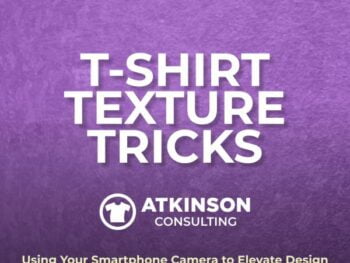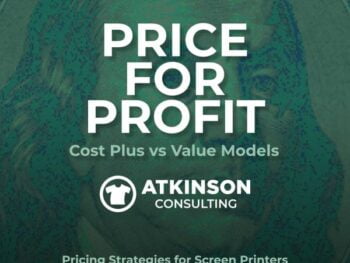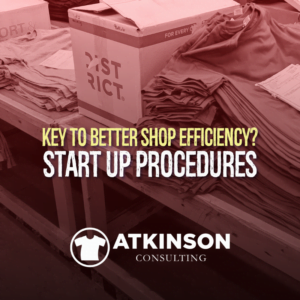I’ve worked in the decorated apparel industry now for about two and a half decades. During that time I’ve met hundreds, maybe thousands, of people in this industry…at trade shows, meet-ups, in their shops, and also on the phone or even on industry forums. We’ve traded stories about what’s working and what’s not. Some are really funny and some just make you shake your head. Like a bobber floating out on a lake when fishing, there are some phrases that I’ve heard or read that will signal a future problem for a shop. Do these excuses sound familiar?
“We’ve always done it this way” This phrase just makes the hairs on the back of my neck stick up as it means there is usually trouble brewing ahead and someone’s head is probably full of concrete. Why? For starters you have to remember that successful businesses always adapt to change. New technology, consumables and methodologies are always being discovered and made available. What worked once will soon be the “old way” of doing something. If you have staff in your shop, especially managers, that have used this phrase recently I would question their ability to lead, grow and find new ways to make your shop run more effectively. “We’ve always done it this way” usually signals someone that is too lazy or apathetic about their work to want to improve. You have to be open to try new things and see if they will work for you, otherwise you are apt to get left behind.
“It’s too hard” Is your shop creatively stagnant because you limit the decoration offering due to not understanding how to do something technically? Some decoration methods require a steep learning curve, and without an available mentorship to show you how to do something with your equipment you just make excuses and never learn that technique. Let me counteract the phrase “It’s too hard” with another phrase that essentially blows it away; “It’s ok to fail”. What squashes that steep learning curve and makes a learning goal attainable is letting go and accepting that you are going to make mistakes, and you can’t be scared of that. That’s how we learn. Thomas Edison once famously said “I have not failed. I’ve found 10,000 ways that won’t work”. So if you really want to learn how to (fill in the blank) then accept that you are going to print or embroider some seriously ugly attempts at first. It may be a complete disaster. It’s ok. Learn from them and improve. Attend a trade show and take a class. Read articles online or in books. Join an industry forum group and ask questions. Talk to your supply chain. Step one is always starting. Get off your butt. Just remember…all those shops that win awards every year at one point didn’t know what they were doing either.
“I’m so tired” Ever notice a weird looking sign or a light on top of a street pole? Once it’s pointed out to you every time you drive by for some reason you have to look at it. That’s the same way for me with this phrase “I’m so tired”. I bet I hear this a few times a week, and not just in my shop either. For some reason, it just sticks out like a sore thumb. As professionals, and for that matter as adults, your responsibility is to show up to work in a good mental and physical condition to do the job. This means plenty of rest, a decent diet, and keeping yourself in good shape. Limit your alcoholic, or whatever, fun during the work week. Trust me, people can tell when you show up to work in a less than perfect state. If you are in a leadership position you are placing your future in jeopardy. Act with some sense.
“I’m not good enough yet” Which is also similar to “I’m not ready yet”. If there’s one thing I’ve learned in my career and that is a good plan that is started today is always better than a perfect plan that won’t start until tomorrow. Don’t wait until things are “just right” to get going with something. Things are never right, and often once you do get started on an initiative you start discovering many ideas that you would have never thought of during the drawing board stage. So don’t wait until things are perfect as that’s an illusion anyway. You are already good enough, and you are also as ready as you will ever be. See the point above “It’s too hard”. Don’t limit yourself.
“It’s their fault” Do you have finger pointers in your shop? These are blamers that all point to reasons why an order didn’t ship on time, inventory wasn’t received in the system properly, the shirts were misprinted, or the image was decorated incorrectly. Mistakes happen, but there’s no personal accountability. Everything that happens in your shop is a team effort, regardless of who worked on the job. Next time a problem comes up instead of starting the blame game, start an initiative to find out how to drop a nuclear bomb on the challenge so it never occurs again. The best thing you can do for your business is get your staff to take ownership of problems. Once you start solving problems and building better ways to do things the challenges may start taking care of themselves. Making this part of your company culture is very difficult, but not impossible. It takes thought. It takes action. Sometimes it takes money, as you need to buy something to solve the problem. To get it going, start discussing your challenges openly, without blaming anyone. Use words like “proactive”, “prevention”, “training”, “quality control”, “teamwork”, and “procedure”. Hold these problems up for everyone to see, and then start constructing the methodology to prevent them from occurring again.
“I can’t find good workers” When I talk to shop owners this is probably the number one challenge cited. They are all looking for a great manual press operator, or a new designer, or an embroidery machine operator, or a fantastic customer service person. Finding the right people sometimes can be very difficult if you are challenged geographically, as maybe the available worker pool is smaller. For every problem there is an answer though. Great talent will come to you if you give them a reason to join your company. Build your company’s culture and let everyone know what a great place your shop is to work. Ideas and contributions matter. Hard work and creativity matter. Having fun and becoming part of a great team is all in a day’s work. One of the best ways I’ve found great people is just training and promoting from within the company. Hire for attitude, train for skill. It’s the longer way around the mountain, but in the end you’ll have a great staff. Cross train people in different departments. Sometimes an average worker in one area can prove to be fantastic in another if just given the chance. I’m a big believer in having at least three people know how to do any critical task in the shop. Need a new press operator? Your puller or catcher should already be trained. Show that embroidery trimmer how to thread the machine and set up your next job. Get your receptionist involved with billing. For more info on cross training read this:
“I’m losing orders because my prices are too high” This is a tough one, as we all serve different facets of this industry. The common theme here is that customers need to appreciate the value that your company brings to the table to be able to justify higher prices. If your client base only views you as a commodity, everything will be price driven. The trick is to find the customers who appreciate the value you give them. The value could be any number of things in your shop, and that is what your business plan should be built upon. Work at building that value and pairing it up with the right customers. Of course, the flipside of that equation is possibly lowering your operating costs so you can be more competitive…or even more profitable. This is where rolling up your sleeves and diving in with a Lean Six Sigma program, sustainability or continuous improvement initiative pays off handsomely. Keeping up the pace and sticking to the direction your customer base is traveling is tough sledding sometimes. As more of your customers shop online, you need to give them more personal and value driven reasons to stay with you. What have you done today to foster better relationships with your customer base? What is your value proposition? If you don’t know, chances are your customers don’t know either. For more info on building a value driven business read this.
“That equipment is too expensive” Or is it? If you have been to a trade show recently you have seen any number of shiny new pieces of equipment on the convention hall floor. I’ve seen you there too. Arms folded, looking through the crowd and trying not to get noticed by the equipment rep as you don’t want to have to tell him that you aren’t prepared to spend that kind of money right now. However, before you cross it off your list completely have you run the numbers? For a lot of shops, they just see the big price tag and not the answers that having that piece of equipment will bring to their productivity to the shop. Newer equipment produces at a faster rate, at a lower cost, with less labor, time and energy. Determine your current state of production with a daily or hourly average. What does that cost you? Time, labor, utilities (electricity, natural gas, or water) maintenance costs (especially with older equipment). Boil that down to a number. Do the same thing with the new machine. Compare. Is there a savings? Will you produce more at a cheaper cost? Multiply that out for the year. What would the Return on Investment (ROI) be? Make sure your math makes sense before you just discard the thought based on a price tag. Sometimes the really expensive decision is NOT doing something.
“Sustainability isn’t worth it” If you’ve read any of my blogs or articles over the few years you know that I’m a big proponent of sustainability. What is it exactly? A sustainability journey is essentially finding ways to Reduce, Reuse or Recycle anything and everything in your shop that you can. Is it hard work? Sometimes; but the financial benefits of building a program in your shop can save you a truckload of money per year if you consistently work at it. Best of all, once you get going it’s the gift that keeps on giving as your operational costs will keep declining…meaning there’s more profit at the end of the year. What’s the number one thing you can do to get started you ask? Get an energy audit. Most utility companies will perform this service for free, and you’ll get a grocery list of things you can do to save money. Look at your HVAC, lighting, and electrical consumption for top things to examine. To build your program, start with a sustainability committee and discuss the top things you can do in your shop and set some SMART goals. (Specific, Measureable, Achievable, Realistic, Timely) If you are a member of SGIA (and if you aren’t you should be) there is a wonderful Peer to Peer group that you can join to help walk you through building a robust program. Once you’ve built your program you should look into getting recognized and certified as a sustainable printer by the Sustainable Green Printing Partnership (SGP). This certification will allow you to leverage your sustainability certification into more business. Sustainability isn’t just an earth-crunchy, good karma, tree hugging way of doing things…its intelligent business operations.
“Social media doesn’t work” If you’ve said this because you only have only 10 likes on your Facebook page, and 21 Twitter followers maybe it doesn’t work for you. However, the good news is that you can change that. First you have to understand that Social Media is all about being social. You can’t just post Me, Me, Me, Me, Me, Sale, Me, Me, Sale, Me over and over and over again and expect anything out of it. That’s not how it works. My recommendation? First, write a comprehensive social media marketing plan that starts with outlining some goals. What do you want out of it? Who are your customers and where do they hang out? Who are your main competitors and what are they doing? This is going to involve some research on your part. Dig in. There’s no point in spending your time on Facebook if all your potential and current customers are using LinkedIn. Social Media requires work, analysis, planning, creativity and sometimes a little luck. Spray and pray isn’t a good strategy. Stop and think about what your objectives are and build your program around them. You also need to spend time engaging with others. It’s not a one way street. To be effective, you need to be interacting with others and find the social media channels that work the best. This requires time, effort, experimentation and the ability to fail and learn from that. Try different things and analyze what works and what doesn’t based on your effort. Set some SMART goals, use a calendar, and make sure your energy pays off in the long run. For more info read this.
“I don’t have time” This is usually code for “I’m horrible at time management”. Sometimes it means “I need to hire more people”. Usually the underlining theme is that whatever the topic is, you don’t value it enough to actually make the time for it. If it was high on your priority list, you would do whatever it takes to accomplish the task. When I’m working on a big project I will break up the work into smaller tasks. If I can, I’ll delegate some to other staff members. Everything gets a due date that’s fair for the work that needs to be accomplished. I use a simple spreadsheet to keep track, and when items are completed I just highlight them with a color. By breaking the huge project into chunks, it doesn’t seem so overwhelming and I can work on it when time permits. If you are putting off something because “I don’t have time” think about breaking that project up into smaller tasks. Usually getting started is half the battle. Want more info on this topic? Read this article.
“I don’t have the right equipment” Are you turning down work because you don’t have the right equipment for the decoration? (Auto screen-printing, embroidery, dye-sub, heat press, etc.) That’s foolish. While you can always buy the right equipment, sometimes that’s not necessary. I always recommend farming these types of jobs out to someone else that can handle it for you. Sure, you’ll make less money than if you did the job yourself…but less money is always more than no money. The trick is to build a network of trusted partners that can handle these types of jobs for you. Believe it or not, there are shops out there that handle contract work as a big part of their business. They can ship third party blind, in your box, with your paperwork. Also, most larger contract shops are members of a PSST program (Pack Separately Ship Together) which means that they get free freight in, so there’s no cost to send the inventory to them from the apparel distributors. Aligning your company with these professionals can mean that you can expand into more areas, or free up time in your shop for other things. Don’t wait until you need them…find a few print or embroidery shops that you feel you can trust and develop a relationship today. Go see their shop, meet the owners, and get set up in their system. Can’t find anyone in your area and don’t know who to trust? Contact me and I’ll help you with your order!
Ok, so now I’m out of excuses… However, I’d love to hear yours! If you want to share, leave a comment or drop me an e-mail and let’s compare notes. matkinson4804@gmail.com






